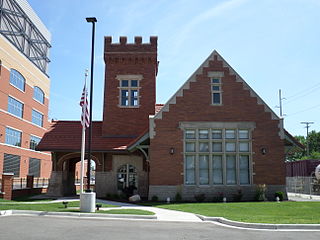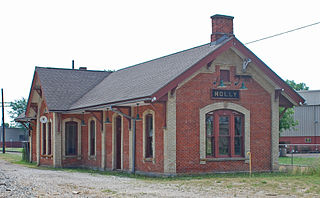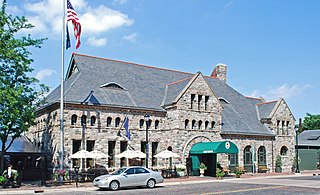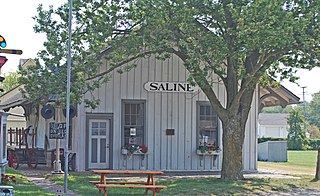
Tower station, often called the Tower Passenger Depot, is a former passenger railroad depot in Tower, Minnesota, United States, that is listed on the National Register of Historic Places. Built in 1916 by the Duluth and Iron Range Railroad, it provided passenger train service until 1951. It currently operates as the Tower-Soudan Historical Society Center museum.

The Kalamazoo Transportation Center is an Intermodal train and bus station in downtown Kalamazoo, Michigan. It is the second-busiest Amtrak station in Michigan, after Ann Arbor. The Kalamazoo Transportation Center serves as the main hub for Kalamazoo Metro local buses, and also serves intercity buses operated by Greyhound and Indian Trails.

Jackson station is a historic Amtrak station in Jackson, Michigan, United States. It is served by three daily Wolverine trains between Chicago and Pontiac and a single daily Amtrak Thruway bus between Toledo, Detroit, Jackson, and East Lansing. The station was added to the National Register of Historic Places in 2002.

Amboy station is a former rail station in the city of Amboy, Lee County, Illinois, United States. The building was constructed as a headquarters building for the Illinois Central Railroad as well as a public train station for the fledgling city of Amboy in 1876. It was designed by railroad staff architect James Nocquet after a fire destroyed the original Illinois Central offices on the site. The building was added to the U.S. National Register of Historic Places in 1992 as the Amboy Illinois Central Depot.

Barnesville station is a historic train station in Barnesville, Ohio. It is located at 300 East Church Street, between Mulberry and Railroad Streets. The building was placed on the National Register of Historic Places on August 8, 1985, as the Barnesville Baltimore and Ohio Railroad Depot.

The East River Road Historic District is a historic district located along East River Road near the Grosse Ile Parkway in Grosse Ile, Michigan. The district is a small island community composed of eleven structures, including seven houses, two outbuildings, St. James Episcopal Church, and the Michigan Central Railroad depot. The district stretches from St. James Episcopal Church on the south to Littlecote on the north. The district was designated a Michigan State Historic Site in 1972 and listed on the National Register of Historic Places in 1973. The historically significant 1870s customs house was moved into the district in 1979.

The Flint & Pere Marquette Union Station, commonly known as the Potter Street Station, is a former railroad station built in 1881 and used until 1950 located at 501 Potter Street in Saginaw, Michigan, United States. It was designed by New York City architect Bradford Lee Gilbert. The station is 285 feet by 40 feet with 2½ stories.

The Chicago, Milwaukee, St. Paul and Pacific Railroad Station, also known as the Milwaukee Road Depot is a railroad depot located at 219 West Fourth Avenue in Menominee, Michigan. It was listed on the National Register of Historic Places in 1982 and designated a Michigan State Historic Site in 1977.

The Nevada–California–Oregon Railway Passenger Station is a historic train station in Lakeview, Oregon, United States. It was built in 1912 by contractor I. A. Underwood from plans by architect Frederic DeLongchamps. It was the northern terminus of the Nevada–California–Oregon Railway. The Southern Pacific Railroad company owned and operated the depot from 1928 until 1975, when it was closed. Since 1978, the building has been used as a law office and later a private residence. Because of its importance to local history, the depot was listed on the National Register of Historic Places in 1983.

The Bloomington freight station is a historic train station in downtown Bloomington, Indiana, United States. Constructed in the early twentieth century, it has endured closure and a series of modifications to survive to the present day, and it has been declared a historic site. Used only occasionally for many years, it is one of the most important buildings in a large historic district on the city's west side.

The Chelsea Commercial Historic District is a historic district located along both sides of Main Street from Orchard to North Street in Chelsea, Michigan; the district also includes the adjacent 100 blocks of Jackson, East Middle, and West Middle Streets, as well as structures on Park, East, and Orchard Streets. It was listed on the National Register of Historic Places in 2011.

Standish is a disused railroad depot located at 107 North Main Street in Standish, Michigan. It was designated a Michigan State Historic Site in 1977 and listed on the National Register of Historic Places in 1991 as the Michigan Central Railroad Standish Depot.

Chesterton is a disused train station in Chesterton, Indiana. The current depot replaced a wooden structure built in 1852 for the Northern Indiana and Chicago Railroad, a predecessor road of the Lake Shore and Michigan Southern Railway, that burned down in 1913. It was rebuilt in 1914 as a brick structure. By 1914, Cornelius Vanderbilt of the New York Central and Hudson River Railroad held a majority interest in the Lake Shore and Michigan Southern Railway. The Southern Railways trackage provided an ideal extension of the New York Central from Buffalo to Chicago. On December 22, 1914, the New York Central and Hudson River Railroad merged with the Lake Shore and Michigan Southern Railway to form a new New York Central Railroad.

The Stillwater Santa Fe Depot is a former railroad station located at 400 East 10th Street in Stillwater, Oklahoma. It served as a rail depot for the Santa Fe Railroad from 1900 until 1958. Now listed on the National Register of Historic Places, it is an example of adaptive re-use of a historic building, serving as the national headquarters for the Kappa Kappa Psi fraternity and Tau Beta Sigma sorority.

The Grand Trunk Western station was a historic railroad station in Lansing, Michigan. The station was listed as a Michigan State Historic Site in 1978, and it was added to the National Register of Historic Places in 1980.

Magnolia station is a historic railway station located at 101 E. Railroad Avenue, in Magnolia, Mississippi. The depot was placed on the National Register of Historic Places in 1984 as The Depot and was designated a Mississippi Landmark in 2006.

Charlotte station is a former railroad depot located at 430 North Cochran Avenue in Charlotte, Michigan. It was listed on the National Register of Historic Places in 2000 as Michigan Central Railroad Charlotte Depot. It has been refurbished as a restaurant, and now houses Don Tequilla's Mexican Grill.

The Holly Union Depot is a former train station located at 223 South Broad Street in Holly, Michigan. It was listed on the National Register of Historic Places in 2000. It sits at the junction of tracks which are now owned by CSX Transportation and Canadian National Railway.

The Ann Arbor station is a former Michigan Central Railroad station located at 401 Depot Street in Ann Arbor, Michigan. It was converted into a restaurant, the Gandy Dancer, in 1970, and listed on the National Register of Historic Places as Michigan Central Railroad Depot in 1975.

The Saline station, also known as the Detroit, Hillsdale and Indiana Railroad-Saline Depot, is a former railroad depot located at 402 North Ann Arbor Street in Saline, Michigan. It was listed on the National Register of Historic Places in 1994. The building now houses the Saline Depot Museum.

























